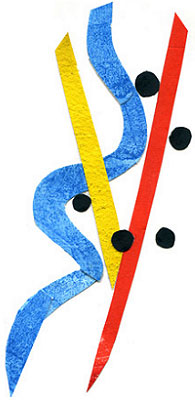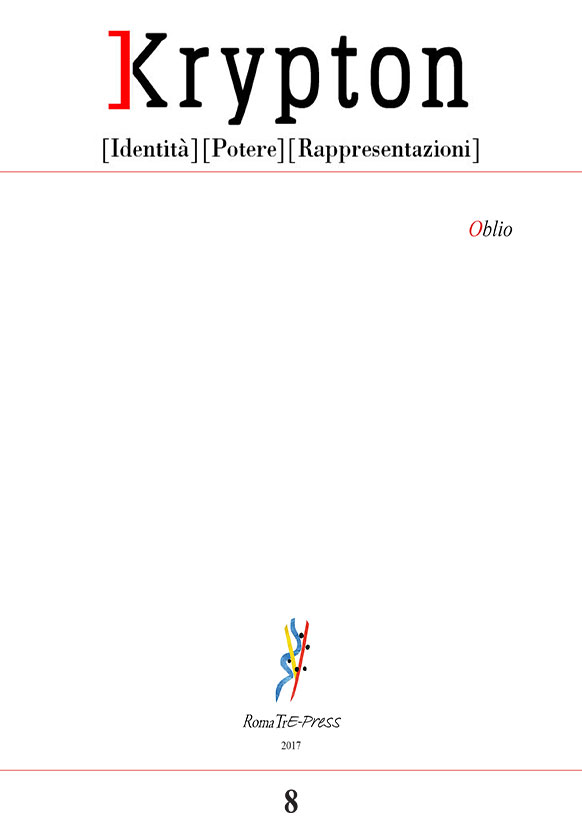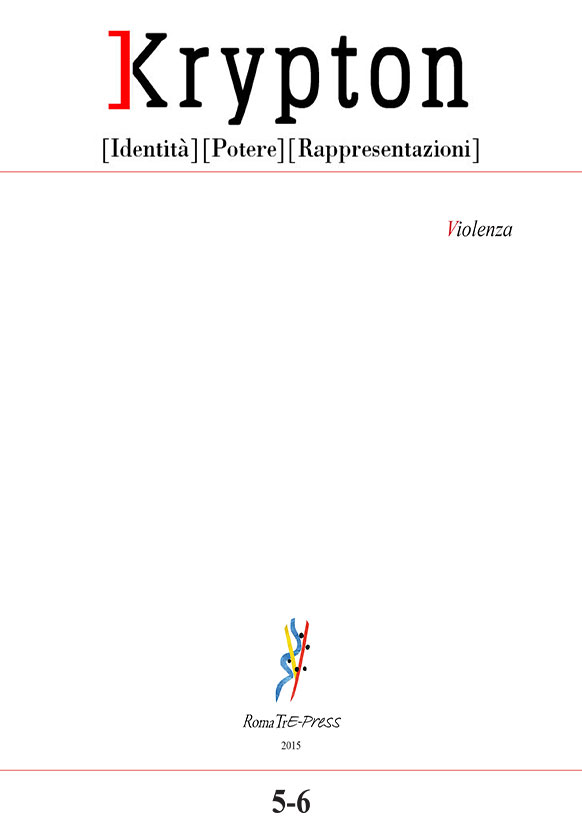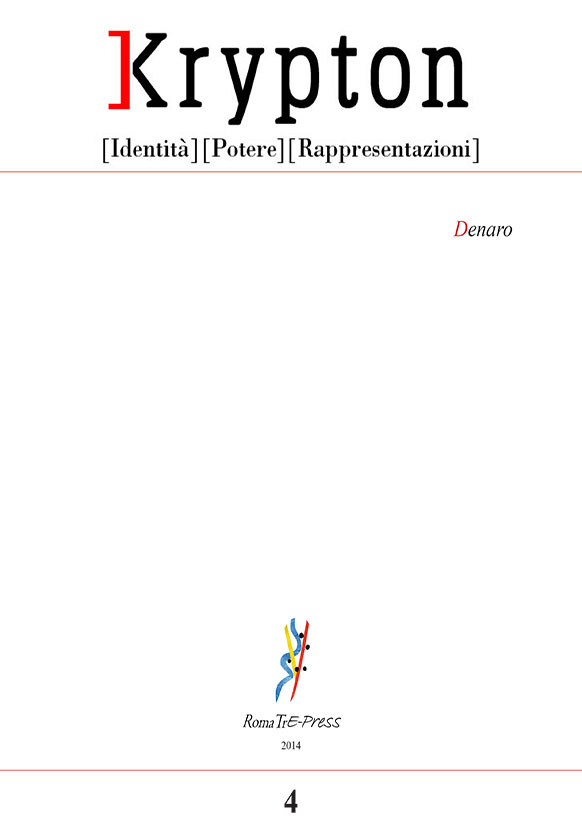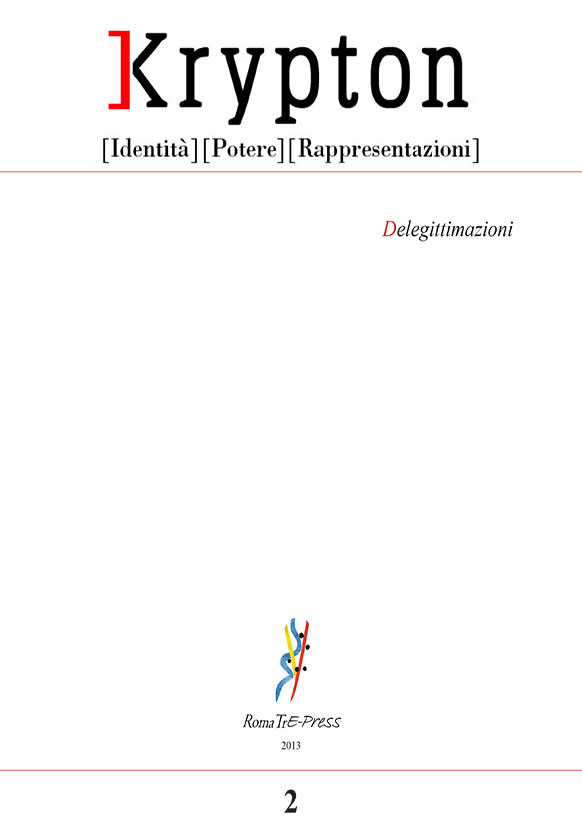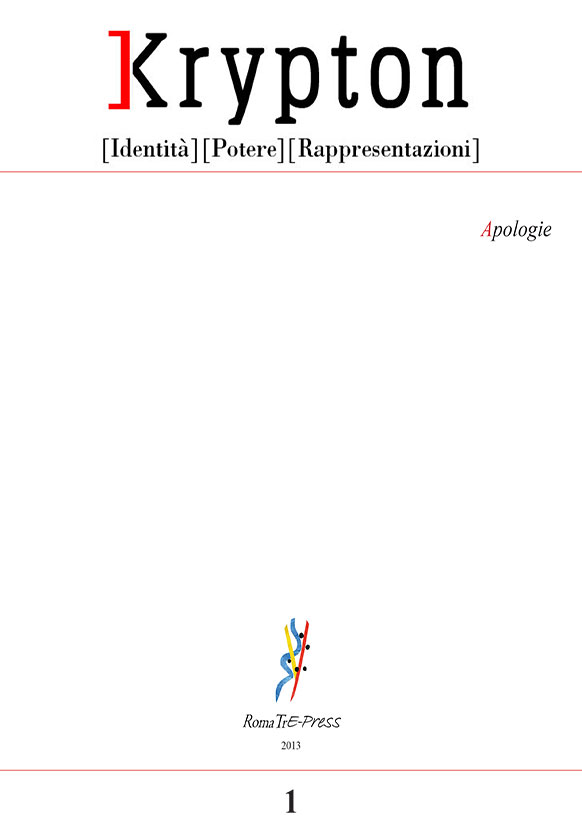Abstract
Periodico semestrale del Dipartimento di Lingue, Letterature e Culture Straniere
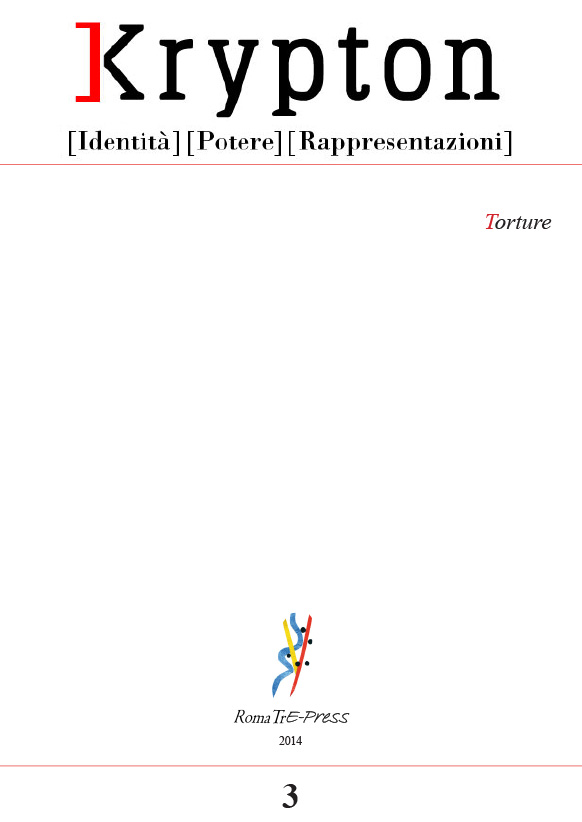
Periodico semestrale del Dipartimento di Lingue, Letterature e Culture Straniere
Il copioso utilizzo delle torture attraverso i secoli ha naturalmente suscitato la riflessione di molti pensatori, filosofi e letterati, ispirando parallelamente e analogamente varie forme di rappresentazione, dai risvolti non di rado aperti e ambigui. L’insieme di queste rappresentazioni, il dibattito sorto attorno alla sua natura e al suo utilizzo, hanno fatto sì che la tortura uscisse da quel cono d’ombra in cui il Potere avrebbe voluto relegarla, divenendo un soggetto spinoso le cui connotazioni etiche non smettono di essere assai problematiche.
DOI: 10.13134/2282-3301/3-2014/1
Resumo:
Neste artigo, trata-se da narração da tortura de François Villon no exórdio do Testament não como um evento traumático na biografia do poeta, mas como o episódio fundador da enunciação poética dessa obra. Climax das provas sofridas pela personagem do célebre malfeitor, a sua tortura na prisão de Meung pelo bispo Thibaut d’Ossigny é apresentada como a causa da sua morte iminente. Mas a sua subsequente libertação pelo rei Luís XI, alegoricamente interpretada como um sinal da graça divina, desencadeia uma reviravolta na vida interior da personagem. Assim, o seu martírio é retrospectivamente reelaborado como uma punição justa pelos erros cometidos na sua juventude, em particular o roubo ao Colégio de Navarra. Nesse sentido, o Testament não está fraturado em uma parte composta antes e outra depois do colapso físico do poeta na prisão de Meung, mas é unificado pelo seu lugar de enunciação que, dramatizando a angústia da personagem do vilão arrependido diante da morte, ilustra a doutrina cristã do perdão.
Abstract:
In this paper, we discuss the narration of the torture of François Villon in the Testament’s exordium not as a traumatic event in the poet’s biography, but as a founding episode of this work’s poetic enunciation. Climax of the tests undergone by the character of the famous wrongdoer, his torture in Meung’s prison by the Bishop Thibaut d’Ossigny is presented as the cause of his imminent death. But his subsequent release by the King Louis XI, allegorically interpreted as a signal of the divine grace, triggers a turnaround in the character’s inner life. Thus, his martyrdom is retrospectively reviewed as a fair punishment for the wrongs commited in his former life, especially the robbery of the Collège de Navarre. Therefore, the Testament is not divided in two parts composed before and after the physical collapse of the poet in Meung’s prison, but is unified by the enunciation’s point of view which, performing the fright of the repentant villain’s character before death, illustrates the Christian doctrine of forgiveness
DOI: 10.13134/2282-3301/3-2014/2
The Treatise of the Instruments of Martyrdom (Italian version 1591, Latin version 1594), published by the Oratorian priest Antonio Gallonio (1556-1605), textually and graphically conveys the hundreds of ways in which persecutors tormented martyrs. It constitutes a clinical and, above all, technical reconstruction of machines used to torture Christians. Yet it was not the horror of blood and gore, nor the pleasure of pain, which Gallonio aimed to impress upon the readership. The underlying message was rather the victory of the impassive faith in God over the ingenuity and inventiveness of engineers. This martyrological machine theatre, however, lost its efficacy as subsequent generations put the work to their own use in the course of the seventeenth and eighteenth centuries. Gallonio’s mechanistic imagery was appropriated by art theorists. Meanwhile, his antiquarian scholarship fed into the juridical and historical fortification of the edifice of the Church. Gallonio’s treatise became a sterile reconstruction of juridical torture. To early Enlightenment thinkers, including Pierre Bayle (1646-1706), the work came to exemplify the cruelty that the Church of Rome seemed to exalt. The legalistic antiquarianism which appropriated Gallonio’s scholarship around 1700 offended a new sensitivity which shunned salvific violence: from a spiritual exercise the treatise became an aesthetic aberration.
DOI: 10.13134/2282-3301/3-2014/3
Resumo:
O culto do touro em Portugal é de longa tradição, como um conjunto de documentos do século XVIII, tanto administrativos como memórias literárias, também atesta. A sua popularidade é abundantemente corroborada, com todos os sectores da sociedade a disputar lugar na assistência para usufruir de um programa completo, que se distribuía por vários dias, ligado frequentemente a uma ocasião notável. Desse programa constavam: música, danças, carros de triunfo, combate de touros e diversos divertimentos taurinos. Infere-se o fausto dos figurinos, a imponência dos carros, o colosso das máquinas. A isto adiciona-se a morte de mais de uma vintena de touros por tarde, à espada, ao rojão, à faca. Entre a facécia e o sangue, o público exulta, participando na representação de uma sociedade histriónica e saciada.
Abstract:
The bull’s endorsement in Portugal has a long tradition, as underlined by a collection of administrative documents and literary memories from the eighteenth century. The popularity of this kind of entertainment is well-attested, since everyone readily disputed a good seat for a complete program of several days, frequently associated with a solemnity. There, the public could find a good array of music, dance, allegoric cars, bull fight and other bull distractions. One can easily infer the luxury of the garments, the majesty of the cars and the gigantic proportion of the machinery. To this, it must be added the killing of more than twenty bulls for afternoon, with the sword, rojão and knife. Between laugh and blood, the public exults, giving rise to the representation of a joyful and totally indulged society.
DOI: 10.13134/2282-3301/3-2014/4
Jean Améry, né en Autriche en 1912 sous le nom de Hans Mayer, est arrêté en Belgique en 1943 et torturé en tant que résistant, puis envoyé dans le camp de concentration d’Auschwitz parce que juif. Rescapé au camp, il s’enferme dans un silence de vingt ans avant de publier Par-delà le crime et le châtiment. Essai pour surmonter l’insurmontable, un recueil de cinq essais, dont l’un directement consacré à la torture, dans lesquels l’expérience personnelle se mêle à la spéculation.
Evénement biographique fondamental, marquant son identité d’individu, tandis que l’expérience des camps de concentration fait office d’un «destin collectif», la torture nous semble constituer le noeud central de son oeuvre; en l’envisageant en tant que traumatisme, nous analysons dans un premier temps l’essai qui lui est consacré, dans un deuxième temps sa présence, souvent inattendue, dans ses autres ouvrages, enfin ses conséquences linguistiques sur Mayer-Améry en tant que sujet et sur son oeuvre d’écrivain.
Abstract:
Jean Améry was born in Austria in 1912 under the name of Hans Mayer. Escaped in Belgium, he is arrested in 1943 by the Gestapo, tortured because of his implication in the Resistance and eventually sent to the concentration camp of Auschwitz as a Jew.
He survives the camp and lapses into silence for twenty years; in 1965 he publishes At the Mind’s Limits: Contemplations by a Survivor on Auschwitz and Its Realities, a collection of five essays in which personal experiences mix up with philosophic speculation. One of them is entirely about torture.
A fundamental biographical event, defining his individual identity whereas the concentration camp experience relates to a «collective destiny», torture is the central nub of his work. Interpreting torture as a destructive trauma, firstly I will examine the essay dealing with it, then its often unexpected presence in the other works of the author, finally its linguistic consequences both on Mayer-Améry as an individual and on his writing.
DOI: 10.13134/2282-3301/3-2014/5
Résumé:
L’écrivain protéiforme Vercors, qui n’est généralement connu que pour avoir publié clandestinement, en 1942, Le Silence de la mer − un livre symbole de la Résistance intellectuelle française − est en réalité l’auteur de bien d’autres récits où les supplices endurés par les Juifs et les Résistants aux cours des ‘années noires’ font l’objet d’une narration fictionnelle témoignant de l’indicible horreur des camps avant même la prise de parole des écrivains censés représenter la ‘littérature concentrationnaire’ de première génération. Vercors dénonce aussi précocement, par son art de narrateur, les tortures perpétrées à l’encontre des civils pendant les ‘années algériennes’, dans le cadre d’un colonialisme désormais agonisant. Cette aptitude à se pencher sur des pans d’histoire trouble et refoulée de la France du XXe siècle se retrouve aujourd’hui chez des romanciers dont les ouvrages incarnent une tendance prononcée de la littérature française actuelle.
Abstract:
The protean writer Vercors, who is mostly known only for having clandestinely published in 1942 Le Silence de la mer [Put Out the Light] – a symbolic book for the French intellectual Resistance – is actually the author of many other stories where the tortures endured by Jews and Resistance members during the ‘Dark Years’ are the subject of a fictional narrative witnessing the unspeakable horror of the concentration camps even before the first-generation of Holocaust writers began to speak. Through his narrative art, Vercors also precociously denounces the acts of torture perpetrated against civilians during the ‘Algerian Years’, in a declining colonial setting. This tendency to focus on blurry and repressed pieces of Twentieth-Century French history can be found today among contemporary novelists whose works mark a significant literary trend in France.
DOI: 10.13134/2282-3301/3-2014/6
Résumé:
Plus de cinquante ans s’étant écoulés de la signature des Accords d’Évian, la torture, qui avait déjà soulevé à ce moment-là un débat animé notamment entre les philosophes et les gens de lettres, est désormais devenue le mot clé de la guerre d’Algérie. Dans cette étude, après un aperçu sommaire de la question d’un point de vue juridique et au terme d’une analyse le plus possible objective des événements algériens concernant la torture, on avance l’hypothèse que cette véritable obsession historiographique pour la violence et la repression ne vise, à l’instar de ce qui s’est passé pour le procès à 89 voire pour le syndrome de Vichy, qu’un but polémique: la mise en cause des idéologies progressistes répandues à l’époque, en l’espèce le jacobinisme et le marxisme.
Abstract:
More than fifty years after the Evian Accords, torture - once a matter of heated discussions among philosophers and people of letters - has become a central topic in Algerian War historiography. The present essay suggests that this new obsession with violence and repression by historians is merely motivated by a polemical purpose. Similarly to what happened with the proceedings against 89 and the Vichy syndrome, the current purpose is to raise concerns about the dominant progressive ideologies of the time, namely, Jacobinism and Marxism. In support of this hypothesis, the essay offers an examination of the issue from a juridical perspective, and an analysis of specific torture cases in the context of the Algerian war.
DOI: 10.13134/2282-3301/3-2014/7
Resumo:
Este artigo é uma reflexão sobre a tortura na biografia de Patrícia Galvão, intelectual brasileira, conhecida como Pagu e uma figura central nos debates sobre a mulher na cena pública. Capaz de romper com as esferas e projeções do privado, o oikos grego que representa o sentido de lar, ela se insere como uma personagem contundente no plano político do Brasil de meados do século XX. Neste trabalho, proponho uma leitura do corpo feminino torturado que, para seguir caminhante, precisa ser rescrito na palavra, na composição de um arquivo que carece de ‘completude’, ora lida na perspectiva da aporia. Assim, impossibilitada da recomposição, afinal o corpo torturado ostenta a perda e a fragmentação, pretendo pensar nessa escritura que responde a um engajamento que a cada dia ganha novos olhares e significados às demandas contemporâneas.
Abstract:
This article is a reflection on the insertion of the torture in the biography of Patricia Galvao, brazilian intellectual, known as Pagu and a central figure in debates about the presence of women on the public stage. Capable of breaking walls and private projections, the Greek oikos that represents the meaning of home, it fits like a pointed character Brazilian’s politic mid-twentieth century. In this paper, I propose a reading of the female tortured body, to keep walking, needs to be rewritten in speech and composition of a file, a ‘completeness’ on the perspective of aphoria. Thus, in an impossible rehab , after all the tortured body shows the loss and the fragmentation, I intent to think about of this scripture answers the engagement, whose every day gains new perspectives and meanings to contemporary demands.
DOI: 10.13134/2282-3301/3-2014/8
Resumo:
Nesse artigo intentamos fazer uma leitura de Salò o le 120 giornate di Sodoma a partir do conceito de paródia, explorado por Giorgio Agamben em texto homônimo, e também nos apoiando nas reflexões desse mesmo autor em Altissima povertà sobre o caráter torturante e anulador que a regra tem ao coincidir ponto a ponto com a vida, tal qual acontece no microcosmo criado por Pasolini nessa obra. Buscamos assim, reafirmar o potencial crítico da última produção cinematografica do cineasta.
Abstract:
In this article we aim to interpret Salò o le 120 giornate di Sodoma, di Pier Paolo Pasolini using the concept of parody which was explored by Giorgio Agambem in his homonymous text, seeking this purpose we have also considered his thoughts in Altissima povertà about torturing and annulling effects that the rules assume when they coincide point to point with life, in the same way it occurs in the microcosm created by Pasolini in Salò. We thereby intend to reafirm the critical potencial of his last cinematographic production.
DOI: 10.13134/2282-3301/3-2014/9
Résumé:
L’article vise à examiner l’émergence et le fonctionnement d’un sous-genre gore, dans les années 2000, films qui ont, sous le nom infâmant de ‘torture porn’, tenté de renouer avec l’horreur viscérale, introduisant au coeur du cinéma de divertissement des représentations troublantes. Il s’agit ici d’analyser la manière dont les films opèrent un glissement de focalisation, du bourreau à la victime, du massacre à la souffrance, qui interroge la pulsion voyeuriste à l’oeuvre chez le spectateur.
Abstract:
The goal of this paper is to study the emerging and mechanisms of a new type of gore movies, which started in the beginning of the 2000s, and have, under the infamous name of ‘torture porn’ tried to come back to true visceral horror, thus producing, inside the field of mainstream cinema, disturbing images. The point here is to analyze the way those films produce a change of focus and address, from the torturer to the victim, from spectacle of slaughter to the exhibition of suffering, thereby interrogating the voyeuristic impulse of the viewer.
DOI: 10.13134/2282-3301/3-2014/10
Résumé:
Les Hunger Games, grand succès de la littérature jeunesse, est une trilogie dans laquelle abondent les occurrences de tortures de toutes sortes. L’examen de ce thème nous permettra d’élucider ses corollaires directs, à savoir l’éthique, la philosophie politique (dans la mesure où la torture peut se justifier par le bien général), mais nous amènera également à nous pencher sur nos valeurs modernes quant à la corporéité et sur les menaces de réification qui pèsent sur le corps et sur le sujet. Tous ces aspects convergent naturellement vers des questionnements sur le totalitarisme, mais aussi et surtout sur les outils de résistance les plus efficaces: contre la torture et contre le totalitarisme, les sujets maintiennent un statut de sujet grâce à une lucidité, une recherche authentique de la vérité et à une spontanéité qui leur permet de contrer la manipulation du réel.
Abstract:
The Hunger Games, a very successful trilogy in popular culture aiming to reach young adult audiences, is surprisingly rich in occurrences of various kinds of tortures. Examining this pervasive theme will cast an interesting light in the matters of ethics, of political theory insofar as torture can be used as a tool to justify the greater good, but will also teach us a lot about our modern society and especially the implications torture has on our notions of corporeality and the potential reification of the body and the subject. All these aspects converge naturally towards the matter of totalitarianism, beautifully exemplified by the Capitol in the Hunger Games, but also, most notably, on the most efficient tools for resistance: against torture as well as against totalitarianism, subjects remain subjects and overcome the reign of manipulated things through lucidity, truth, authenticity and spontaneity.
DOI: 10.13134/2282-3301/3-2014/11
